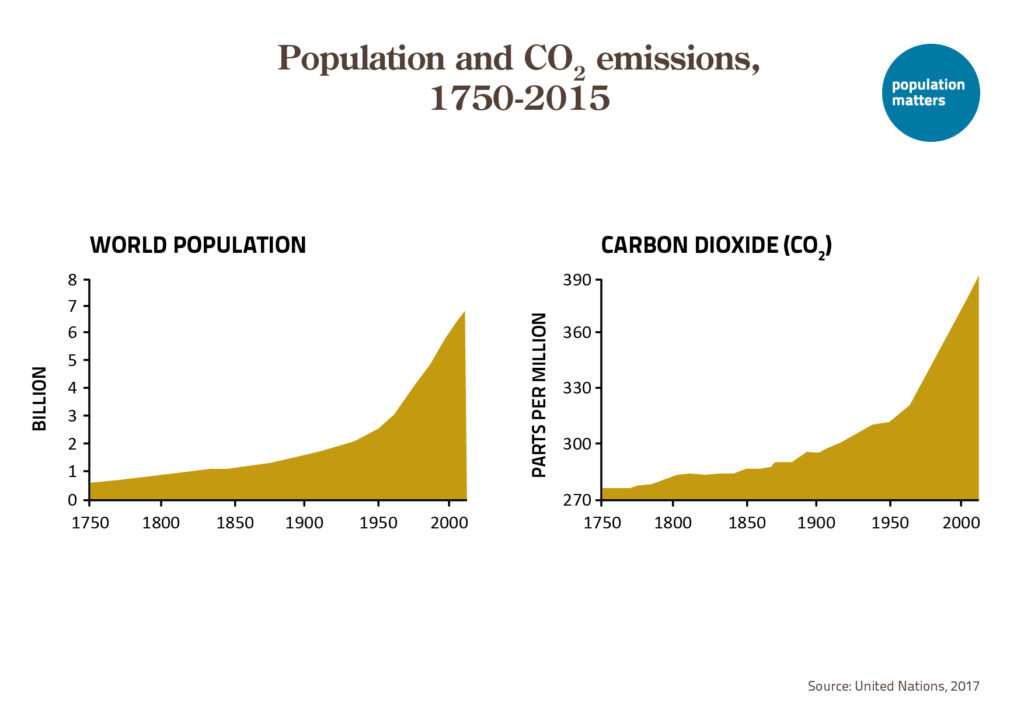
IPCC 1.5° Report: will it grasp the population nettle?
5 October 2018
Immediate use
IPCC 1.5° Report: will it grasp the population nettle?
The critical report of the International Panel on Climate Change due for release on Monday is intended to identify significant dangers in allowing temperatures to exceed 1.5° and propose vital measures to prevent and, if needed, mitigate such an increase (1). Campaigning charity Population Matters is calling on the IPCC to include action to tackle population growth in its prescriptions.
While the IPCC has previously referred to the contribution of population to global emissions (2), it has not so far proposed action to address it. If the report does call for such action, it will mark a significant step, reflecting growing consensus within the climate change and scientific communities:
- Project Drawdown, a major report on solutions to climate change has identified girls’ education and family planning (key mechanisms in reducing birth rate and population growth) as, in combination, the most effective available policy measure in reducing emissions (3).
- 20,000 scientists have endorsed a Second Warning to Humanity published in Bioscience in 2017 which describes population growth as a “primary driver” of environmental problems, including climate change, and calls for immediate action to achieve a sustainable population (4).
- A paper published in Environmental Research Letters in 2017 identified that for individuals in the developed world, having one fewer child is the most effective action they can take in reducing their carbon emissions – by a factor of 20 over the next most useful action (5).
- A 2012 Lancet paper identified that reductions in population growth could reduce global emissions by 40% or more in the long term (6).
- The IPCC’s own 5th report on climate change in 2014 noted that “Globally, economic and population growth continued to be the most important drivers of increases in CO2 emissions from fossil fuel combustion” (2).
These conclusions are borne out by historical evidence (8):

Robin Maynard of Population Matters said:
“We’re well aware that the IPCC report is the subject of horse-trading and political realities. We will need to see what emerges from the meeting in Incheon but failure to address population would undermine the credibility of the entire exercise – when the world needs confidence that whatever can be done, is being done. The scientific consensus on this is growing – and everyone can grasp that more emitters means more carbon. Of course, multiple other steps must be taken to address climate change but every other solution is rendered less effective by increasing numbers.
The good news is that addressing population brings multiple other benefits. What we want is more women’s empowerment, more modern family planning, more education, more people moving out of poverty and action taken to encourage and incentivise smaller families. These are voluntary, ethical, effective and practical solutions which everyone can and should endorse. Most certainly, the IPCC must.
ENDS
Contact:
Alistair Currie, Head of Campaigns and Communications
E: alistair.currie@populationmatters.org
T: +44 (0)208 123 9170
Notes to Editor
IPCC Special Report Global Warming of 1.5ºC. The Intergovernmental Panel on Climate Change (IPCC) will meet in Incheon, Republic of Korea, on 1-5 October 2018, to consider the Special Report Global Warming of 1.5ºC. Subject to approval, the Summary for Policymakers will be released on Monday 8 October with a live-streamed press conference.
Project Drawdown, an international collaborative project, involving 70 research fellows from 22 countries and six continents. It ranked the top 80 practical, available mechanisms for cutting carbon emissions, by tonnage of CO2 saved. Educating girls was ranked no 6 (59.6 gigatonnes CO2-equivalent reduction) and family planning at no 7 (also 59.6 GT). Combined, they save more carbon than onshore and offshore wind combined, and more an any other action. https://www.drawdown.org/solutions-summary-by-rank
World scientists warning to humanity: a second notice, W.Ripple et al (2017). The warning states: “We are jeopardizing our future by not reining in our intense but geographically and demographically uneven material consumption and by not perceiving continued rapid population growth as a primary driver behind many ecological and even societal threats” It calls for “further reducing fertility rates by ensuring that women and men have access to education and voluntary family-planning services, especially where such resources are still lacking” and for “estimating a scientifically defensible, sustainable human population size for the long term while rallying nations and leaders to support that vital goal.” The paper was originally signed by 15,000 scientists and now stands at more than 20,00 signatures. BioScience, Volume 67, Issue 12, 1 December 2017, Pages 1026–1028 https://academic.oup.com/bioscience/article/67/12/1026/4605229
The climate mitigation gap: education and government recommendations miss the most effective individual actions, Wynes and Nicholas (2017). Environmental Research Letters. “Having one fewer child (an average for developed countries of 58.6 tonnes CO2-equivalent (tCO2e) emission reductions per year), living car-free (2.4 tCO2e saved per year), avoiding airplane travel (1.6 tCO2e saved per roundtrip transatlantic flight) and eating a plant-based diet (0.8 tCO2e saved per year)”. http://iopscience.iop.org/article/10.1088/1748-9326/aa7541
Demographic change and carbon dioxide emissions, O’Neill et al (2012), The Lancethttps://www.thelancet.com/journals/lancet/article/PIIS0140-6736(12)60958-1/fulltext
Climate Change 2014 Synthesis Report, International Panel on Climate Change (2014):
“Anthropogenic greenhouse gas emissions have increased since the pre-industrial era, driven largely by economic and population growth and are now higher than ever.” And “Globally, economic and population growth continued to be the most important drivers of increases in CO2 emissions from fossil fuel combustion.”
Source: WWF. (Graphic based on original graphic presented by Glyn Davies, Director of Global Programmes, WWF, 2017)
